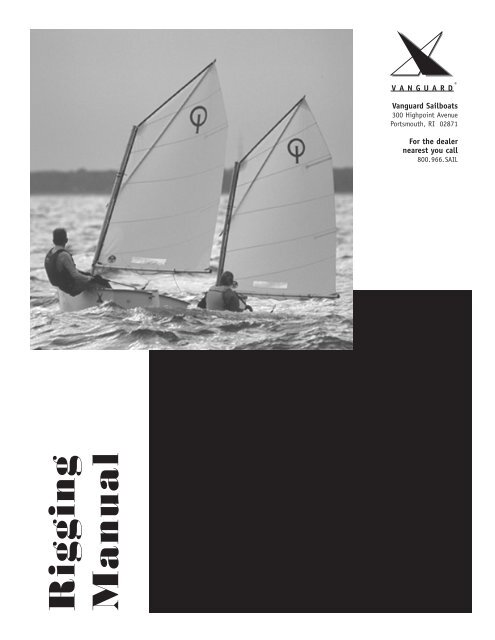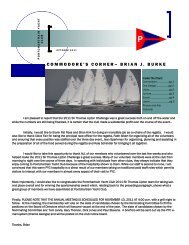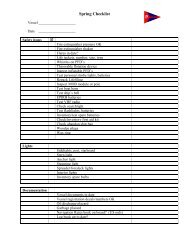Opti Rigging Guide
Opti Rigging Guide
Opti Rigging Guide
You also want an ePaper? Increase the reach of your titles
YUMPU automatically turns print PDFs into web optimized ePapers that Google loves.
Vanguard Sailboats<br />
300 Highpoint Avenue<br />
Portsmouth, RI 02871<br />
For the dealer<br />
nearest you call<br />
800.966.SAIL<br />
<strong>Rigging</strong><br />
Manual
Getting Started<br />
Unpacking and preparation<br />
Unpack the major parts and lay them out on a soft piece of ground free of sharp objects. To<br />
avoid damaging contents, do not cut into packaging.<br />
1. Hull<br />
2. Mast kit which includes:<br />
Mast (fattest)<br />
Sprit (thinnest)<br />
Boom (gooseneck jaw)<br />
3. Boat kit which includes:<br />
Sail<br />
Tiller<br />
Rudder<br />
Daggerboard<br />
Micro block<br />
Mainsheet clip<br />
Mainsheet block<br />
w/ becket<br />
Shackle<br />
4. Line kit which includes:<br />
Sail and Corner ties<br />
Daggerboard retainer line<br />
Mainsheet<br />
Mast tie in retainer<br />
Boom preventer line<br />
Upper sprit halyard<br />
Lower sprit halyard<br />
Outhaul<br />
Painter<br />
Safety mainsheet bridle<br />
Mast Collar<br />
Super Glue<br />
Knots<br />
Tools<br />
To rig your <strong>Opti</strong>mist the<br />
first time, you will need<br />
the following tools:<br />
2 Adjustable wrenches<br />
Pliers<br />
Knife<br />
White electrical tape<br />
Small flathead screwdriver<br />
1 www.teamvanguard.com
Sprit halyards installation<br />
Attach the micro block to one end of the upper sprit halyard and<br />
feed the other end through the block on the forward side of the<br />
mast. Tie a bowline in the other end.<br />
Attach the lower sprit halyard to the top of the clam cleat on the<br />
forward side of the mast. Feed the other end through the micro<br />
block and down through the clam cleat. Leave loose until the sprit<br />
is attached.<br />
Masthead detail: Tie one corner tie through the eyestrap at<br />
the top of the mast to keep the sail in tight against the spar. Tie<br />
another down through the lower eyestrap, to keep the sail below<br />
the masthead when the sprit is tensioned.<br />
Upper<br />
sprit halyard<br />
Lower sprit<br />
halyard<br />
Assembly<br />
Sprit installation<br />
1. Lay the sprit along the top edge of the sail so that the chafe<br />
collar lines up against the mast and the opposite end lines up with<br />
the peak, as shown in the parts locator. Slide the plastic knob on<br />
the top end of the sprit into the loop on the peak of the sail. Pass<br />
the loop of the upper sprit halyard over the knob on the bottom<br />
end of the sprit.<br />
2. The lower sprit halyard adds purchase to the upper sprit halyard,<br />
to make it easier to tension. To rig it, tie one end to the top<br />
of the clam cleat on the front of the mast. Pass the tail up through<br />
the block that drops from the sprit and back down through the<br />
cleat. The tension on this line is a crucial sail adjustment.<br />
Sail assembly<br />
Spread out the sail, making sure there are no sharp objects nearby.<br />
Line up the mast and boom with the proper edge of the sail<br />
as shown in the parts locator, and attach them to the sail with the<br />
sail ties, using an “optimist knot” (a square knot with an extra<br />
overhand on top of it.) Use the longer corner ties to attach the<br />
peak, tack, and clew, and wrap them twice around the spar before<br />
knotting.<br />
Mast collar installation<br />
The mast collar tightens the fit of the mast in the boat, and its<br />
location on the mast is crucial. Step the mast and carefully mark a<br />
line on the mast at the top of the mast hole. Then remove the<br />
mast, slide the collar onto it, and superglue it so that the top edge<br />
of the collar is on the line.<br />
Masthead Detail<br />
www.teamvanguard.com<br />
2
Assembly<br />
Boom<br />
Boom installation<br />
If you haven’t already done so, clip the boom onto the mast. Tie<br />
a knot in one end of the boom preventer line and thread the other<br />
end up through the hole in the port side of the boom jaw. Then<br />
pass the line around the mast above the retaining knob and back<br />
down through the hole in the other side of the boom jaw. Tie a<br />
stopper knot below the boom jaw.<br />
Outhaul<br />
Tie a knot in one end of the outhaul and pass the other end forward<br />
through the port hole in the outboard end of the boom.<br />
Thread the line through the clew grommet from port to starboard,<br />
back through the starboard hole in the boom from forward to aft,<br />
and forward to the cleat. Tie a stopper knot in it to keep it from<br />
coming unrigged.<br />
Mainsheet<br />
Outhaul<br />
Locate the mainsheet block (with becket) and attach the spring<br />
clip to its shackle. This will clip onto the boom when you are ready<br />
to sail. Run the mainsheet through the ratchet block in the bottom<br />
of the boat AGAINST the ratchet, through the mainsheet<br />
block, and through the forward block in the boat toward the stern.<br />
Tie off the tail to the mainsheet block’s becket, and tie a stopper<br />
knot in the other end.<br />
Vang<br />
Tie the vang line into the end of the wire attached to the boom,<br />
and lead it down to the clam cleat on the mast and up through the<br />
cleat. Tie a stopper knot in the end.<br />
Mainsheet<br />
Vang<br />
3 www.teamvanguard.com
Daggerboard<br />
Attach the daggerboard retaining line to the forward edge of the<br />
daggerboard; this line will keep the board from separating from the<br />
boat in the event of a capsize.<br />
Rudder<br />
Remove the bolt(s) and nut(s) from the aft end of your tiller.<br />
(Fiberglass blades have two bolts as shown; wood blades have<br />
one.) With the tiller extension on top, slide the tiller over the rudder<br />
head and line up the hole(s), then pass the bolt(s) through.<br />
Tighten the nut(s) enough so the tiller will stay at the height you<br />
want.<br />
Stepping the mast<br />
Make sure the bow of the boat is pointing into the wind and that<br />
there are no overhead electrical wires in the area. Also make sure<br />
the mast step hole and mast butt are clean. Stand up the rig and<br />
lift up the base of the mast until it clears the rail of the boat; then<br />
ease it down through the hole in the thwart and into the mast cup.<br />
Immediately secure the mast with the mast tie in retainer with a<br />
square knot, which ties into the eyestrap forward of the mast step<br />
and then around the mast, above the vang cleat. Now you are<br />
ready to launch!<br />
NOW YOU ARE<br />
READY TO SAIL<br />
FOR YOUR OWN SAFETY, MAKE SURE<br />
YOU ARE WEARING APPROPRIATE<br />
CLOTHING FOR THE CONDITIONS,<br />
AND PLEASE OBTAIN PROPER TRAINING<br />
BEFORE SAILING. HAVE FUN AND<br />
DON’T FORGET YOUR LIFEJACK-<br />
ET!<br />
Launching<br />
Launching<br />
With the boat close to the water’s edge or in the water, slide the<br />
rudder onto the gudgeons, lining up the lower one first. Make sure<br />
the rudder stop prevents it from sliding off the boat; if necessary,<br />
bend it out slightly. Slide the daggerboard into the daggerboard<br />
trunk. (You will have to turn the boat sideways to the wind to keep<br />
the boom clear.) Drop it down as much as depth permits and loop<br />
the shockcord around the board so the plastic tubing sits on the<br />
trailing (aft, sharp) edge. Tie off the daggerboard retaining line to<br />
the forward side of the daggerboard trunk. Clip the mainsheet onto<br />
the boom bridle and pull in any slack.<br />
Rudder & Launching<br />
Unrigging<br />
When approaching shallow water, pull up the daggerboard as much<br />
as possible without obstructing the boom. After you hop out of<br />
the boat, unclip the mainsheet from the boom. Remove the daggerboard<br />
and place it in the boat. To remove the rudder, depress<br />
the stop and lift it off. Once the boat is on land, collapse the boom,<br />
sprit and sail against the mast and remove the rig from the boat.<br />
Remove the sprit, untie the sail from the mast, and roll it up<br />
against the boom for storage. You can leave the mainsheet rigged<br />
in the boat, and the vang line attached to the wire.<br />
Daggerboard<br />
Sail care<br />
All gear should be rinsed, if sailing in salt water, and the sail should<br />
be allowed to dry before it is rolled up. Removing the battens from<br />
the pockets between uses will increase the life of the elastic that<br />
holds them in. Make sure the window is not creased when you fold<br />
the sail.<br />
Mast Step<br />
www.teamvanguard.com<br />
4
Tuning Tips<br />
Mast rake<br />
Mast rake is an important measurement for successful <strong>Opti</strong>mist<br />
racing, but it is not necessary to adjust it for every different<br />
breeze. As a general rule, set your mast up so that it is perpendicular<br />
to the deck; this will keep the boom parallel to the water.<br />
To check the rake, hook a tape measure to the top of your mast<br />
and measure to the transom where the deck lip and transom intersect.<br />
The table below shows the best range of mast rakes for different<br />
crew weights; experiment to see what works best for your<br />
sailing style. More rake (lower numbers) usually improves pointing,<br />
but may compromise downwind speed.<br />
If you are overpowered, try raking the mast further aft and pulling<br />
the daggerboard up a few inches to help keep the boat flat.<br />
Sprit adjustment<br />
Adjusting the sprit is a crucial sail control, and should be done with<br />
the rig in the boat. As a starting point, tighten your sprit just<br />
enough to form a wrinkle from peak to tack when there is no load<br />
on the mainsheet. Then raise your sprit for stronger winds (to<br />
tighten the leech) or lower it for lighter winds (to give it more<br />
shape).<br />
Crew Weight<br />
Mast Rake<br />
(lbs.) (cm) (in)<br />
84-92 280-282 110 1/4 - 111<br />
92-103 282-284 111 - 111 3/4<br />
103-110 284-286 111 3/4 - 112<br />
5/8<br />
5 www.teamvanguard.com




